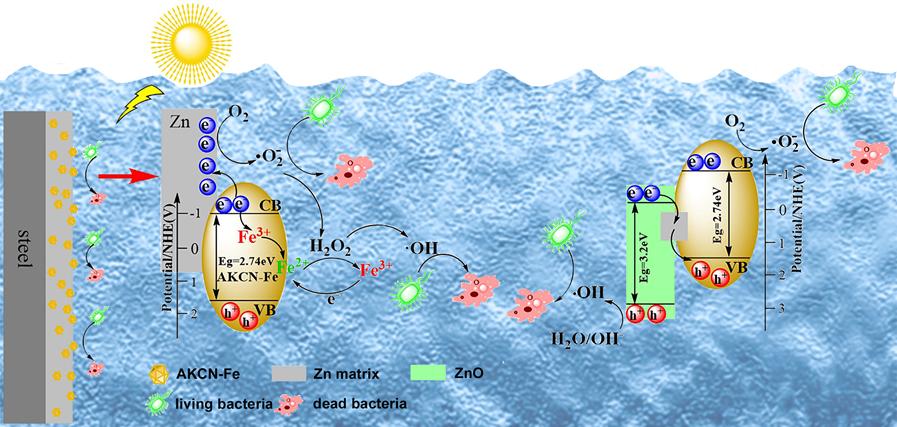Researchers Fabricate A New Antibacterial Zn Composite Coating
Marine microbial corrosion and biofouling are regarded as serious problems threatening marine constructions, leading to economic loss and safety problems. Currently, a novel and green photocatalysis technology based on semiconductors, which facilitates the conversion of clean solar energy into chemical energy, has attracted considerable interest for its potential applications in antibacterial aspect.
Metal coatings possess high mechanical strength and high binding force with steel substrate, which made them an ideal carrier for photocatalytic particles. Among all these metal coatings, Zn coating processed relatively low self-corrosion potential and good barrier effect, so it was considered as an excellent corrosion-resistant coating for steel.
Recently, the research team led by Prof. DUAN Jizhou from the Institute of Oceanology, Chinese Academy of Sciences (IOCAS), proposed an antifouling Zn-based composite coating by coupling g-C3N4-based photocatalysts into Zn electrodeposits, illustrated the co-electrodeposition process and then clarified the antibacterial mechanism in typical marine fouling microorganisms.
The study was published in Nano Materials Science on Feb. 14.
Researchers found that the g-C3N4-based photocatalysts participated in the electrodeposition after being chelated with Zn2+ through the active sites on the g-C3N4-based photocatalysts such as N atoms of the amino groups and O atoms of the hydroxyl groups, and then the chelates were composited into Zn-based coatings to form composite coatings with smooth and shining surfaces.
The antifouling properties of the composite coatings were evaluated in typical marine fouling microorganisms such as P. aeruginosa, E. coli, and S. aureus by detecting the activity of inhibiting the adhesion of bacteria on the coating surface.
Results revealed that the prepared composite coatings showed a relatively high surface antibacterial ratio up to 98%. Under visible light irradiation, the superoxide and hydroxyl radical produced by the coatings led to the dramatic antifouling properties. The Zn/AKCN-Fe coating showed the highest visible-light-driven antibacterial activity, resulting from the highest photocatalytic activity and loading content of AKCN-Fe.
"The AKCN-Fe photocatalysts formed Schottky junctions with Zn, which effectively reduced the recombination probability of electrons and holes," said Prof. DUAN.
The present research can effectively enhance the application prospects of g-C3N4-based photocatalysts and Zn-based coatings.
This work was supported by the National Natural Science Foundation of China, the Basic Frontier Science Research Program of the Chinese Academy of Sciences, the Strategic Leading Science and Technology Program of the Chinese Academy of Sciences, and the Shandong Key Laboratory of Corrosion Science.

The illustration image of the mechanism for photocatalytic inhibition of bacterial adhesion
DUAN Jizhou
Institute of Oceanology
E-mail: duanjz@qdio.ac.cn
(Editor: ZHANG Yiyi)